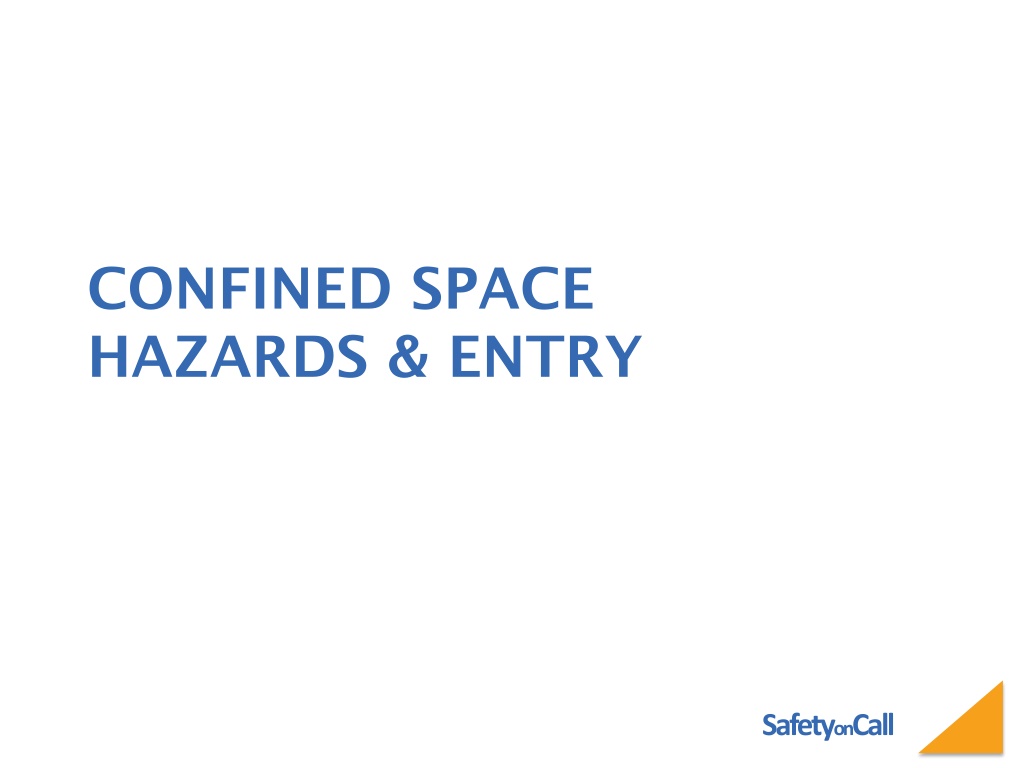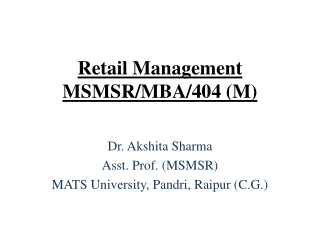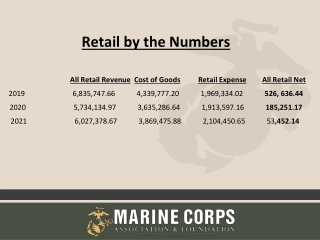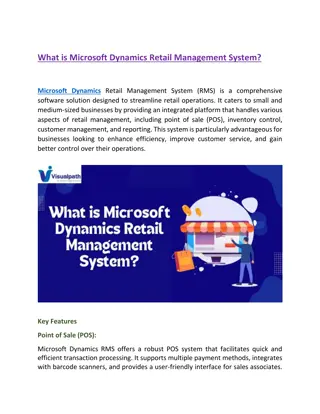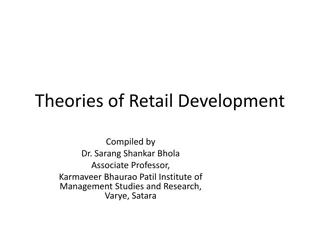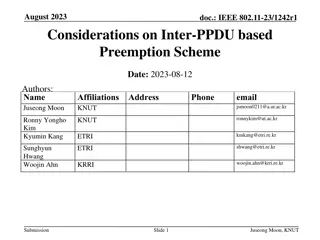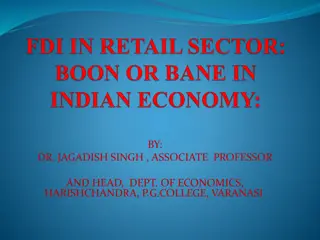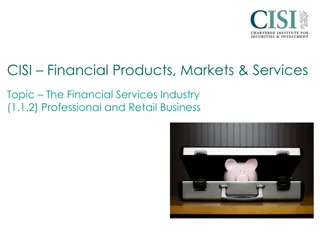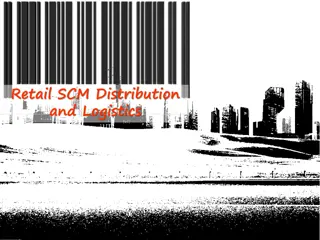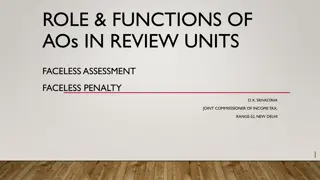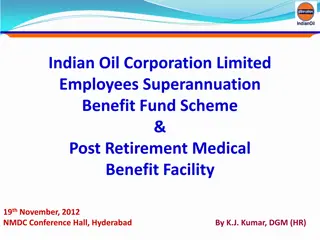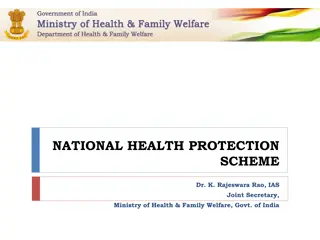Review of Covid-19 Online Retail Scheme 2022
The Irish Government Economic and Evaluation Service (IGEES) conducted a spending review in 2022 on the Covid-19 Online Retail Scheme. The review analyzed the impact, outcomes, and effectiveness of the scheme in supporting Irish-owned retailers during the pandemic. Key findings highlighted the approval rates, funding distribution, and positive impact on online sales, website traffic, and staff retention. Recommendations for future calls include addressing application concerns and conducting follow-up evaluations for long-term outcomes.
Uploaded on Feb 20, 2025 | 0 Views
Download Presentation

Please find below an Image/Link to download the presentation.
The content on the website is provided AS IS for your information and personal use only. It may not be sold, licensed, or shared on other websites without obtaining consent from the author.If you encounter any issues during the download, it is possible that the publisher has removed the file from their server.
You are allowed to download the files provided on this website for personal or commercial use, subject to the condition that they are used lawfully. All files are the property of their respective owners.
The content on the website is provided AS IS for your information and personal use only. It may not be sold, licensed, or shared on other websites without obtaining consent from the author.
E N D
Presentation Transcript
CONFINED SPACE HAZARDS & ENTRY SafetyonCall
WHAT YOU WILL LEARN What is a Confined Space Hazards of Confined Spaces Basic Entry Requirements SafetyonCall
GENERAL REQUIREMENTS All employees required to enter confined or enclosed spaces must be instructed in: Nature of the hazards. Necessary precautions to be taken. Use of protective and emergency equipment. SafetyonCall
WHAT IS A CONFINED SPACE? Is large enough and so configured that an employee can bodily enter and perform assigned work. Has limited or restricted means for entry or exit (for example, tanks, vessels, silos, storage bins, hoppers, vaults, and pits are spaces that may have limited means of entry.) Is not designed for continuous employee occupancy. SafetyonCall
WHAT IS A PERMIT REQUIRED CONFINED SPACE? A Permit-required confined space is confined space that has one or more of the following characteristics SafetyonCall
PERMIT REQUIRED SPACES Contains or has a potential to contain a hazardous atmosphere. Contains a material that has the potential for engulfing an entrant. Has an internal configuration such that an entrant could be trapped or asphyxiated by inwardly converging walls or by a floor which slopes downward and tapers to a smaller cross- section. Contains any other recognized serious safety or health hazard. SafetyonCall
TYPICAL CONFINED SPACES Boilers & Furnaces Pipelines Pits Process Vessel Silo & Storage Tanks Sewer & Manholes Trenches & Excavations SafetyonCall
HAZARDS OF CONFINED SPACES Atmospheric Physical Configuration Mechanical Electrical Thermal Noise Vibration Engulfment or Entrapment SafetyonCall
CONTROLLING CONFINED SPACE HAZARDS Each Confined Space has different hazards. Hazards can also change with time and usage. Post signs to warn of the dangers. Use barriers to prevent uncontrolled access Develop and use a written space entry program. SafetyonCall
CONTROLLING CONFINED SPACE HAZARDS Conduct air monitoring and tests to identify and evaluate hazards. Define acceptable entry conditions. Monitor entry conditions. Eliminate or control the space's atmospheric hazards before entry. Lockout all internal hazards prior to entry. SafetyonCall
ENTRY POINT HAZARDS Small Openings make entry and rescue difficult. Sharp edges can tear protective clothing or air lines. Temporary ladders and vent gear can make even large openings difficult to transit. Vertical entry points are fall hazards. SafetyonCall
VENTILATION NEEDED Deadly gases can be trapped inside. Rotting Organic materials create hazardous gases. Pipe leaks, welding, system material can create hazardous atmospheres. Rust consumes the oxygen you need. SafetyonCall
ATMOSPHERIC HAZARDS Oxygen Deficient Atmospheres Oxygen Enriched Atmospheres Flammable Atmospheres Toxic Atmospheres Corrosive Atmospheres Asphyxiating Atmospheres SafetyonCall
OXYGEN DEFICIENT 19.5 % is the minimum acceptable oxygen level for work with out an air supplied respirator. 12-14% - Poor judgment. 10-12% - Lips blue Mental Confusion. 8-10% - Fainting & Nausea. 6-8% - Causes Death. SafetyonCall
ASPHYXIATING ATMOSPHERES Reduction of oxygen in a confined space may be the result of either consumption or displacement. Consumption of oxygen takes place during: Combustion of flammable substances. Bacterial action, as in the fermentation process. Chemical reactions as in the formation of rust. SafetyonCall
OXYGEN ENRICHED Oxygen level above 21%. Causes flammable and combustible materials to burn violently when ignited. Such as: Hair, clothing, oil soaked materials. Never use pure oxygen to ventilate. Never store or place compressed gas tanks in a confined space. SafetyonCall
FLAMMABLE ATMOSPHERES Required Factors: Oxygen Flammable Gas, Vapor or Dust Ignition Source Welding Electric Tools Sparks Smoking SafetyonCall
FLAMMABLE ATMOSPHERES Caused by: Enriched oxygen atmospheres. Vaporization of flammable liquids. Byproducts of work. Chemical reactions. Concentrations of combustible dusts. Fumes from chemicals on inner surfaces. SafetyonCall
TOXIC ATMOSPHERES Material in space: Absorbed materials can gas off . Decomposition of materials. Work being performed: Welding, cutting, brazing, soldering Painting, scraping, sanding, degreasing Sealing, bonding, melting Cleaning, de-scaling SafetyonCall
CORROSIVE ATMOSPHERES Corrosive atmospheres can be not only a respiratory problems but also cause skin exposure reactions and damage to your nervous system though skin absorption or breathing. Examples of Corrosives: Bleach Ammonia Acids SafetyonCall
PHYSICAL CONFIGURATION HAZARDS The use and shape of a space can create hazardous conditions: Use of Ladders & Scaffolding. Wet or slippery surfaces. Uneven bottoms. Bends in tunnels. Narrow areas that can entrap workers. Poor lighting. Use retrieval & fall protection when possible. SafetyonCall
MECHANICAL HAZARDS Some confined spaces have unguarded mechanical equipment such as: Paddles Blades Shafts Chain or belt drives All equipment must be Locked and Tagged before entry. SafetyonCall
ELECTRICAL HAZARDS Electric Shock is a possible hazard in Confined Spaces. Hazard Sources include: Broken lighting. Electrical sensing devices. Limit switches. Level indicating devices. Hazards from equipment taken inside. SafetyonCall
TEMPERATURE HAZARDS High and Low Temperatures are Hazards Burns Frostbite Heat Stress Wearing Protective clothing can increase the heat stress on a worker. SafetyonCall
WORKER COMFORT Factors affecting worker comfort: Air temperature Air velocity though the space Humidity Radiant heat Protective Clothing Activities SafetyonCall
ENGULFMENT HAZARDS Engulfment is the entrapment of a person by the contents of a space. Liquids Small granular product such as grain. Crusting or Bridging of material. Flooding Water Flow SafetyonCall
ENGULFMENT HAZARDS Completely empty the contents before entry. Use retrieval and fall arrest equipment to prevent sinking into contents of a space. SafetyonCall
NOISE HAZARDS Noise creates a hazard by: Causing hearing loss. Preventing communication. Lowering worker's effectiveness. Eliminate noise sources prior to entry. Use proper hearing protection. SafetyonCall
SURFACE HAZARDS Slippery, Wet or Damp Surfaces Slips & Falls Chemical exposure. Possible increased chance of electric shock. Uneven surfaces. SafetyonCall
VIBRATION HAZARDS Vibration of the body can cause damage to the body. Using Vibrating tools can cause damage to fingers & hand. Eliminate equipment vibrations prior to entry. Use Vibration dampening tools & gloves. SafetyonCall
BASIC CONFINED SPACE ENTRY PROCEDURE All entrants, supervisors and entry attendants must be fully qualified: 1. Conduct Pre-Entry Briefing. 2. Assemble and check equipment. 3. Establish Acceptable Entry Conditions. 4. Conduct initial air sampling. 5. Execute & Complete Entry Permit. 6. Station Entry Attendant. SafetyonCall
ENTRY (CONTINUED) 7. Establish Monitoring of Atmosphere 8. Establish Communication 9. Execute Hot Work Permit if applicable 10. Post Confined Space Entry Permit 11. Enter Space 12. Post entry debrief if problems were encountered SafetyonCall
TESTING THE ATMOSPHERE Verify presence of safe work atmosphere. Calibrate Air Monitoring Equipment before use. Test all areas of a confined space. Top, Middle & Bottom. Check for Explosive & Toxic Gases. Check Oxygen level. Record all readings. SafetyonCall
VENTILATION Consider best of exhaust or supply or both. Provide work zone exhaust if welding. Plan ventilation supply and exhaust paths. Ensure no re-circulation of air supply. Use continuous ventilation. Retest the confined space before and during entry. SafetyonCall
LOCKOUT! Lock & tagging ALL electrical sources. Blank & bleeding fluid lines. Disconnect mechanical drives &shafts. Secure mechanical parts. Lock & Tag all valves. SafetyonCall
RESCUE TEAM A qualified rescue team and rescue equipment must be available for entry into all Permit Required Confined Spaces. Qualified Entry Attendant must be in constant communication with workers in the space. Entry Attendant must have source of communication with the Rescue Team. SafetyonCall
SUMMARY All persons involved in Permit Required Confined Space Entry must be qualified: Supervisor Attendants Entrants Rescue Team Confined Spaces are Dangerous Places Know how to control or eliminate hazards. SafetyonCall
